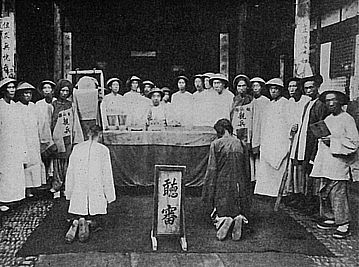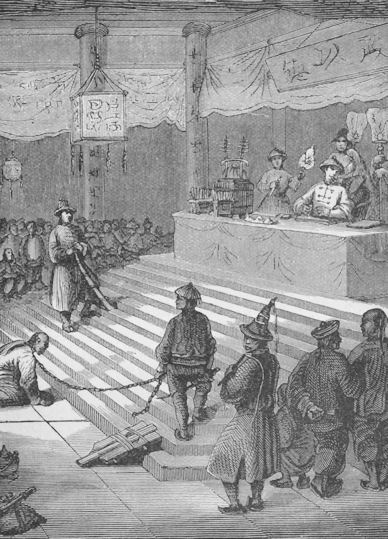
Content created: 2002-04-22
File last modified:

The following texts are from the Qīng dynasty (period 21) legal code, as translated into English by George Thomas Staunton and published in 1810. The Chinese title would today be transliterated Dà Qīng Lǚlì 大清律例. It means "Laws and Procedures of the Great Qīng 清 Dynasty" and was modeled in close detail on the legal code of the preceding Míng 明 dynasty (period 20), which in turn had great continuity with preceding Chinese legal codes.
If you wish to cite his original text, it is:
- STAUNTON, George Thomas (tr.)
- 1810 Ta Tsing leu lee, being the fundamental laws, and a selection from the supplementary statutes, of the penal code of China. London: T. Cadell & W. Davies.
- (A 1966 Taipei facsimile edition of Staunton's book is available at the UCSD library under call number "K0 .C45478 Circ Annex.")

Pre-Modern Law Codes. It is impressive that the Imperial Chinese code could be compact enough to fit into a single English volume of under 600 pages. That conciseness tells us something about how different the Chinese legal system was from the modern ones that we know, which of course fill whole libraries with their laws. Obviously in Imperial China, a magistrate was expected to make decisions based on the law, morality, local custom, and his reading of the individual situation. And his decisions were not intended to be precedents for much of anything else.
The same is true for all pre-modern law codes. It is only in modern times that information technology allows law codes to be too big for any single person to read and allows a judge's raised eyebrow in one district to become a precedent for legal decisions elsewhere. Through most of history, life was simpler. (In fact, many of the sections of the Chinese code actually have one or more "clauses" added to them to provide examples of their application. Staunton has normally omitted these or relegated them to appendices. All are omitted here. If all were included, the book would have been somewhat larger. But only somewhat.)
Staunton's Translation. Staunton's edition contains a small number of obsolete spellings and/or press errors that I have corrected here. I have also removed some cross-references to other clauses that are irrelevant here. And I have converted statute numbers from Roman numerals to Arabic ones. If you cite the work from this rendering, I suggest you add the line "On-line revision by David K. Jordan" so as not to attribute my minor changes to the original edition. This version is also available as a 22-page PDF file (link).

Staunton divides the code into 436 "sections," blocked into divisions and books. The Chinese text (which can be found in the UCSD library under DS755 .C43473 volumes 211-220) is continuously numbered at the level of Staunton's books. I have added the Chinese numbers in square brackets here, referring to numbered items as sections. I have rehearsed the reference numbers in red at the top of each page of text. I have set off Staunton's footnotes in maroon boxes.
What Is Included Here. What is reprinted here is of course a tiny proportion of the whole legal code. I have selected the parts related to family relations to give you an idea of how they are represented in the late Imperial legal system. The following table of contents has links to the text for all or most of the portions asterisked (and, in most browsers, underlined).
Go to next page
Return to top.